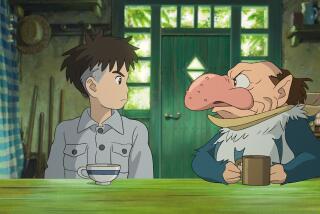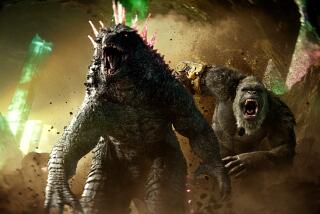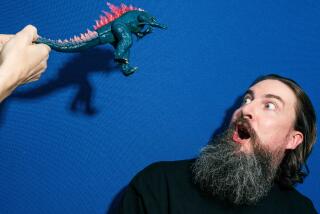Godzilla Returns to His Japanese Stamping Ground
Godzilla is rearing his big, ugly head on the screen once more, this time reverting back to his Japanese form--that is, looking more like a lava-encrusted gorilla with a tail who likes walking upright than a lizardly Tyrannosaurus rex who likes slithering about.
“Godzilla 2000,” which opens today, is the first American theatrical release of a Toho Studio Godzilla movie in 15 years. Toho, one of Japan’s major filmmakers, debuted the creature in 1954 and has spun off 22 profitable sequels since.
The lizardly Godzilla, the American interloper created in 1998 by director Roland Emmerich and producer Dean Devlin for TriStar, was a mega-stomping, mega-effects extravaganza. He was all computer graphics, while the Toho Godzilla was and remains the man in the rubber suit, gleefully careening over carefully crafted scale models of Japanese cities and smushing them to smithereens. “Get Ready to Crumble” is the current advertising catch phrase.
Godzilla rumors have spun fast and furiously the last few years. Some said Toho had licensed Godzilla to TriStar for three movies, others said for five years, and still others said for all non-Japanese releases. Masaharu Ina, general manager of Toho Company Limited Los Angeles, noted that in his company’s “Godzilla vs. Destoroyah” (1995), the beast was killed off to “make room” for the TriStar version.
In an interview translated in the North American Godzilla fan magazine G-Fan, Toho producer Shogo Tomiyama acknowledged that the decision to make “Godzilla 2000” came abruptly.
“Actually we had no plans for another Godzilla film until the year 2005,” he said. “[The change of heart] came about, I will admit, because now TriStar’s ‘Godzilla’ is Godzilla. We had a feeling that after seeing TriStar’s film, we couldn’t keep [the Japanese Godzilla] silent until 2005.”
What TriStar purchased, Ina explains, was the license to make a Godzilla feature and a sequel. But the rights to make Godzilla in the classic Japanese style remain with Toho.
“We have always been able to produce our own Godzilla picture,” Ina said, “and if TriStar wants to distribute our Godzilla picture, they have to obtain the rights from us. So in this case they did so.”
The 1998 TriStar “Godzilla” cost an estimated $170 million to make and market. Though it was considered a box-office disappointment, the film did take in $385 million worldwide.
“That means that something along the lines of 100 million people saw the film,” says Jeff Blake, president of worldwide distribution for Sony Pictures, which owns TriStar. “That speaks to the U.S. franchise being alive and well.”
Even in Japan, where critics grumbled about it, the film made about $60 million at the box office. “Godzilla 2000” is working on a more modest scale, having been made for $11 million; it pulled in a solid $16 million in Japan. Now the beast is poised for a U.S. run for the money.
The Opposite of State-of-the-Art
“ ‘Godzilla 2000’ is a throwback to the classic Toho character, the opposite of the state-of-the-art science-fiction film which is being made today,” Blake says. “That is, despite some 500 computer-generated effects in the new film, we still know it’s a guy acting out Godzilla.”
Neither Toho nor TriStar see any problem with two Godzillas coexisting side by side. (TriStar says its own sequel is “in development,” and Toho is shooting another “Godzilla” this year in the new series.) After all, they look and act different, and the audience should be able to distinguish one from the other.
Especially discriminating will be the hard-core fans of the monster, some of whom were put off by the TriStar Godzilla. In fan magazines and Web sites they cited unforgivable departures from the “real” Godzilla. For example, Godzilla is a mammal and not a reptile as shown in the American version. (This may derive from the fact that the Japanese name for the creature, “Gojira,” comes from two words, one meaning “gorilla,” the other meaning “whale”--both, of course, mammals.) The Japanese Godzilla is charcoal gray, not green, and he shoots radioactive breath, not fire, and so on.
Many picked up that the TriStar Godzilla, with its heavy-jawed dinosaurian features and raptor-like progeny, owed more to “Jurassic Park” than to the Japanese monster.
“This was the most disappointing movie of all time!” one fan wrote in to G-Fan. “We wanted them to copy the Godzilla movies, but instead got ‘Jurassic Park 3.’ ”
Other fans noted a more profound divergence. “The original Godzilla came about because of nuclear testing in the South Pacific, so it was kind of an indictment of the use of nuclear weapons,” observes Jeff Adams, a longtime fan who recently came to Los Angeles for the G-Fest 2000 festival at the Roosevelt Hotel. “Godzilla is a force of nature, and the Japanese have a great respect and fear for the monster. The American Godzilla was just evil.”
Adams is touching on a point that evolved in the Godzilla sequels--that while the giant goes knocking down everything about him, he often ends up knocking down another monster that poses an even greater threat to humans.
In the last decade, Daiei Studio, the other Japanese studio with a major kaiju (“monster”) franchise, revived its protagonist Gamera, the flying turtle, with a fresh injection of engaging storytelling and human characters. These have been some of the most profitable films in the Japanese domestic market, although they have not been exported to this country as theatrical releases.
“In Japan we make monster movies because we can’t make war movies,” director Shusuke Kaneko once mused on the set of his third Gamera film. “Making war movies is too controversial because of our role in the last war, it raises too many touchy issues.”
Indeed if one looks at his Gamera films, Japan’s “Self-Defense Force” looks suspiciously like the full-fledged Army, Navy and Marines. In battling invasions of pestilent and gargantuan monsters, the government sends out divisions of soldiers, tanks, artillery and F-15 jet fighters.
Why do kaiju have such a penchant for attacking Japan? Kaneko believes it is because of transgressions of natural order, because in seeking economic development and success, the Japanese have damaged the environment. He points out that in the first part of “Gamera 3,” the monsters destroy Shibuya, one of Tokyo’s trendiest districts--representing new Japan; in Part 2, they destroy Kyoto, representing old Japan.
Monster Hero Saves the People
These days, the plot of most kaiju films runs like this: Mankind is threatened by a plague of fiendish aliens or hellish creatures that look like giant crayfish, pterodactyls, preying mantises crossed with tarantulas, etc. After their cruel destruction of life and property, our Monster Hero arrives.
Some humans fear the monster and seek to destroy him; others believe he is our savior. There ensues a life-and-death struggle in which the giants careen about and destroy half of whichever city they find themselves in.
In addition to sending out heat rays, radioactive rays, laser rays and various other ear-splitting destructo-screeches or beams, the monsters always resort to mano a mano combat. This is another humanizing effect that put these creatures on the level of, say, sumo wrestlers, especially when they start thumping around on their hind legs, kick up the sand, and the extra bits of fins and blubber flop about their body.
“Godzilla 2000” follows this pattern. In the film, a giant rock from the bottom of the ocean turns out to be a spaceship that’s been buried there 60 million years. When revived, it becomes bent on world domination, zipping into Tokyo and plopping atop a building with a computer mainframe for telecommunications, then jamming everyone’s mobile phone and Internet service.
Meanwhile, government bureaucrat-maniac Katagiri (Hiroshi Abe), head of the Crisis Control Intelligence Agency, is obsessed with destroying Godzilla; monsters are bad for humans, ergo all monsters must die. A couple of scientists doubt that equation--they believe we can learn something from the hulk that never dies.
Toho has already responded to current audience taste by presenting a Godzilla with a newly buffed-up, lean and mean body and action sequences that are markedly more realistic, including use of computer imaging.
Still, notes Sony executive Michael Schlesinger, “this film needed to be Americanized somewhat. Americans are used to a faster pace, more sounds effects and music.”
So nine minutes were cut out, bigger noises and music were added. And, of course, all the voices were dubbed since the film is meant for wide release and a large kiddie audience. The studio did decide to have the English dialogue read by Asian American actors, actors with a distinct foreign accent.
“It’s a Japanese movie, they should be speaking with Japanese accents,” Schlesinger says.
So why did TriStar decide to pick up the Toho Godzilla? Timing, says Schlesinger, who believes that “baby boomers who watched these films back in the ‘50s and ‘60s have their affection for Godzilla, and those with kids will bring their kids.”
More to Read
The biggest entertainment stories
Get our big stories about Hollywood, film, television, music, arts, culture and more right in your inbox as soon as they publish.
You may occasionally receive promotional content from the Los Angeles Times.










